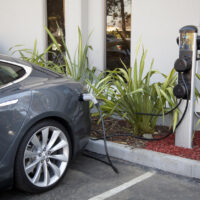Electric vehicles have been in the spotlight recently, with major automakers pushing to eliminate regulations that mandate increasingly electrified vehicle fleets through the national zero emissions vehicles (ZEV) sales mandate.
The ZEV mandate is an important policy lever under the Electric Vehicle Availability Standard, Canada’s federal strategy to decarbonize the passenger transportation sector. The principle is simple: vehicle manufacturers and importers must sell a minimum share of zero emissions vehicles as part of their total annual sales. This share will increase over time, creating stronger incentives to sell more zero emissions vehicles. The sales mandate aims for ZEVs—which includes fully electric and hybrid electric vehicles—to reach 20 per cent of all new light-duty vehicle sales next year. By 2030, that share ramps up to 60 per cent, and then 100 per cent in 2035.
Getting more ZEVs on the road is an essential part of reducing emissions and realizing Canada’s climate ambitions. Passenger transportation emissions currently account for 53 per cent of transportation emissions, and a sizable 12 per cent of the total economy. When ZEVs displace gasoline cars, passenger vehicle emissions on the road decline.
Recent public debate about the ZEV mandate and EVs generally has produced some unfortunate misconceptions. Here, we debunk three common myths.
Myth 1: Amid falling first quarter 2025 sales, ZEVs are no longer desirable
After years of consistently increasing market share, ZEV sales slumped in the first quarter of 2025 and some automakers have taken this as a sign that overall demand is slowing down.
However, a likely reason for the downturn is that federal and provincial consumer rebates were removed in the early part of the year. That almost certainly contributed to the drop in sales, as upfront costs are often a major hurdle to adoption.
There is a larger role here for the ZEV mandate, however. In years when ZEV sales are lower, the sales mandate will be especially important as a consistent signal that anchors market certainty in the demand for ZEVs, and prevents backsliding of investments in ZEV manufacturing. So when demand seems to be slowing down, the mandate pushes automakers and importers to further improve supply, and offer ZEVs at more competitive prices.
This anchoring is especially important for Canada not to fall behind as the global trend continues to push in the direction of ZEVs. ZEVs are consistently improving their economies of scale and reaching closer to breaking even with gasoline vehicles. Battery prices continue to decline, and are expected to drop by half next year compared to 2023. These price drops in ZEV components are continuing to close the gap in costs between ZEVs and fossil-fuel vehicles.
It’s also worth noting that the decline in EV sales has also not been for all automakers and importers. General Motors announced that it achieved positive variable profitability across its EV lineup in 2024. That means that when only considering labour and materials costs, EV products made a profit. There are other capital costs involved in retooling factories that will still need to be paid off in order to turn a net profit, but this is positive news for a major North American automaker. GM also saw an impressive 252 per cent year-over-year growth in sales over the first quarter of 2025 in Canada.
From the consumer’s perspective, research also shows there is significant room to grow. Canadian consumers still want ZEVs. Recent survey results from Clean Energy Canada and Abacus Data found that 45 per cent of Canadians were inclined to get an EV, with even higher shares among younger Canadians and those living in urban areas.
Lastly, not all provinces currently have access to EV options. Availability of EVs across the country remains concentrated in a few provinces and there is limited access for Canadians who want to test drive EVs. The ZEV mandate is designed to bridge this gap between demand and supply. Automakers and importers have historically prioritized supply chains in B.C. and Quebec where provincial ZEV mandates are already in place—as well as big markets like Ontario. A sales mandate improves the availability of ZEVs in other provinces by requiring automakers and importers to make those vehicles more available in other jurisdictions.
Myth 2: Automakers and importers will either be forced to pay a $20,000 penalty for each excess gasoline vehicle they sell, or forced to restrict sales
The ZEV mandate has a credit mechanism in place to add flexibility for automakers and importers who are unable to meet the required share of EVs in a given year. Companies that perform better than their ZEV targets can generate credits for battery electric vehicles and partial credits for certain plug-in hybrid electric vehicles. Companies that fail to meet a target can generate a deficit for up to three years. These credits can either be banked or traded for up to five model years.
Alternatively, companies can generate a credit by making $20,000 investments in fast-charging infrastructure. So it’s not necessarily as if the mandate will force companies to hand over cash to the government. They can either buy or trade credits at market prices, or they can make charging infrastructure investments, which could potentially also open charging infrastructure revenue opportunities and address a significant bottleneck to EV adoption.
But before automakers and importers are required to make fast-charging infrastructure investments, they can also increase the demand for ZEVs by cross-subsidizing some of the cost of an EV to gasoline vehicles. ZEV costs are another significant barrier to adoption, and one way automakers and importers can increase EV sales is by spreading the costs across their non-ZEV models, which in turn decreases the sticker price of ZEVs for consumers.
Myth 3: We don’t need a ZEV mandate because of other policies
Recent experience suggests that the ZEV sector still requires a broad range of policy support, including consumer rebates and additional charging infrastructure funding. However, these other supporting ZEV policy measures are complementary, and not a substitute to the ZEV mandate.
Consumer rebates to date have been a widely popular policy tool driving ZEV adoption, with government funding used up earlier than expected for the federal Incentives for Zero-Emission Vehicles (iZEV) Program. Provincial programs like B.C.’s Go Electric Rebates have also been spent earlier than anticipated due to a surge in interest. As a result, Quebec re-opened its Roulez vert program in March, and the federal government is signalling that they will be bring back the rebates.
Funding for charging infrastructure such as the federal government’s Zero Emission Vehicle Infrastructure Program supports the ZEV ecosystem by increasing availability of chargers across the country. These charging stations will be especially useful in addressing concerns from those who do not have regular access to at-home charging such as those living in multi-unit buildings, and renters, or people undertaking long-distance travel. Public funding can also support equity in the transition by making ZEV ownership practical for rural, remote, and underserved communities.
While rebates and charging infrastructure remain important enablers, they must be paired with policies and strong signals that improve ZEV availability. By setting clear and lasting sales targets and giving manufacturers flexible tools to comply, the mandate helps shift the Canadian vehicle market toward cleaner options, giving consumers more access to ZEVs no matter where they live.








